Want to buy or sell something? Check the classifieds
-
The Fedora Lounge is supported in part by commission earning affiliate links sitewide. Please support us by using them. You may learn more here.
You are using an out of date browser. It may not display this or other websites correctly.
You should upgrade or use an alternative browser.
You should upgrade or use an alternative browser.
The BORSALINO BROTHERHOOD
- Thread starter Dakota Ellison
- Start date
Finally found one and had to dig pretty deep (for my standards that is) to get it.
Borsalino Gulaela homburg in Bismuto in Castoro (beaver) felt. Size 56 with the bound brim at 6cm and the crown at 11cm at the center dent. Finally found a Castoro felt. A few members here have one, but these things are rare! The felt is fantastic and it is fairly light at 111 grams. The sweatband does not have the Borsalino logo, so could be a replacement, even though the hat doesn't seem to have been worn very much.









Made especially for Michele Balbi of Napoli. Interestingly it came wrapped in this nice piece of ephemera: a paper Barbisio bag.

Borsalino Gulaela homburg in Bismuto in Castoro (beaver) felt. Size 56 with the bound brim at 6cm and the crown at 11cm at the center dent. Finally found a Castoro felt. A few members here have one, but these things are rare! The felt is fantastic and it is fairly light at 111 grams. The sweatband does not have the Borsalino logo, so could be a replacement, even though the hat doesn't seem to have been worn very much.
Made especially for Michele Balbi of Napoli. Interestingly it came wrapped in this nice piece of ephemera: a paper Barbisio bag.
Haven't come across any Borsalinos for a while, then suddenly, I bag 6 of them. This one was the first to arrive. Quite new, even still has the tag. Not up to the quality of vintage Borsalinos, but it looks nice. I was drawn by the colour and the fact that it was sold in Petitgas; Denmark's oldest, still in existence hat shop.
At 8cm, the brim is no stingy.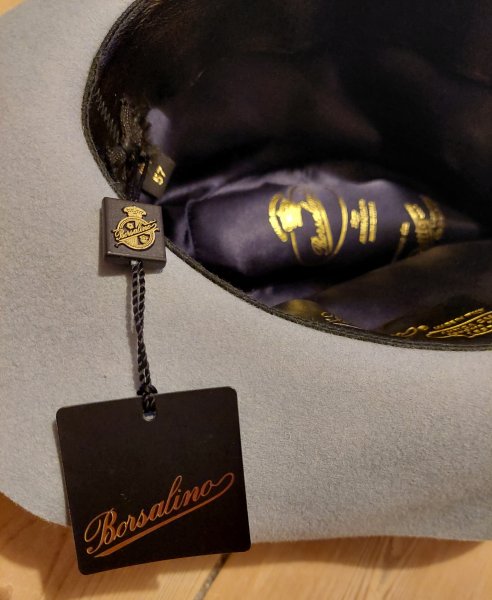
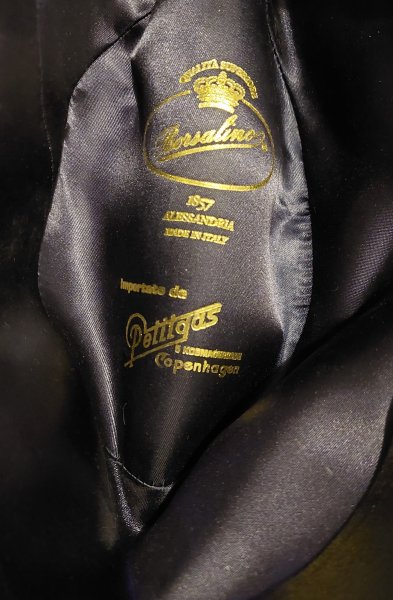
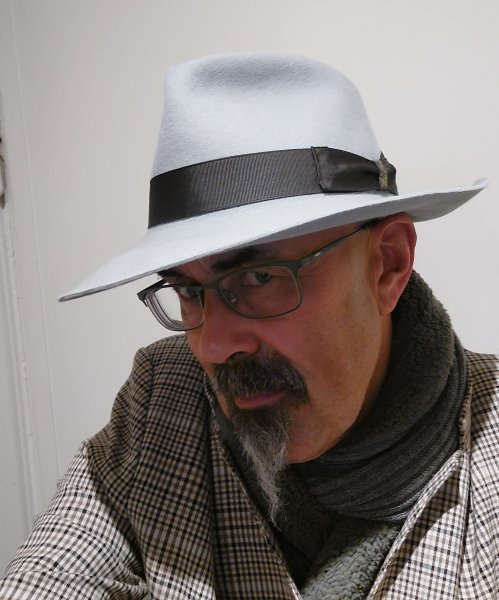
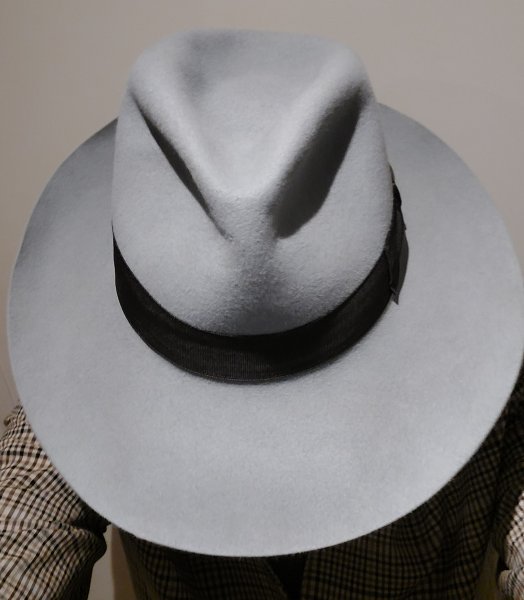
At 8cm, the brim is no stingy.




Six!? Now that is some score, Steve. The first one is a nice classic looking hat. Already curious about the others.Haven't come across any Borsalinos for a while, then suddenly, I bag 6 of them. This one was the first to arrive. Quite new, even still has the tag. Not up to the quality of vintage Borsalinos, but it looks nice. I was drawn by the colour and the fact that it was sold in Petitgas; Denmark's oldest, still in existence hat shop.
At 8cm, the brim is no stingy. View attachment 373376 View attachment 373377 View attachment 373379 View attachment 373380
Six!? Now that is some score, Steve. The first one is a nice classic looking hat. Already curious about the others.
Thanks Stefan. Quality wise, it's not up to Borsalino standards of yore, but, as you say, it has a good look to it.
Stay tuned for the next 5. 4 haven't arrived yet.
The second of the 6 recent Borsalino purchashes arrived today. Yet another Facebook Market Place find.
Late 1950s / early 60s if I'm reading the label right. Wonderful hand to the dense felt. Shark gill bow treatment, and a double stitched overwelt edge. The 5cm brim seems to say up, but can equally be worn down. Win-win.
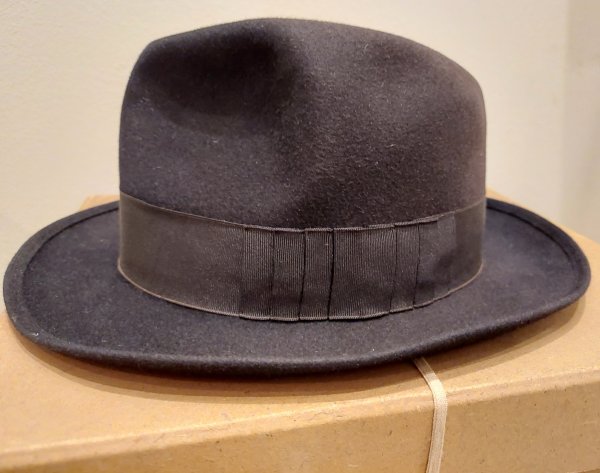
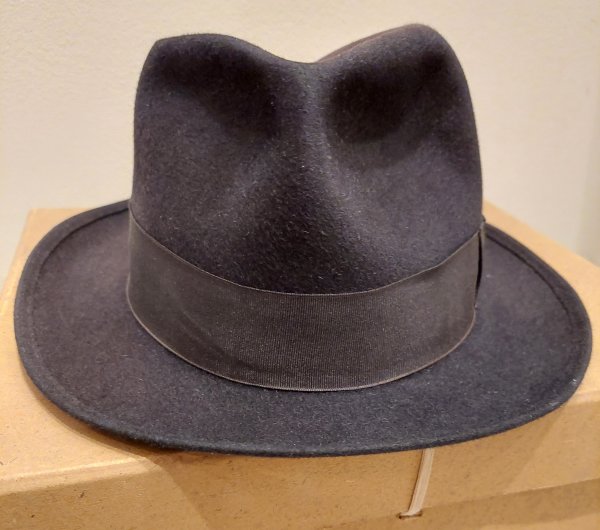
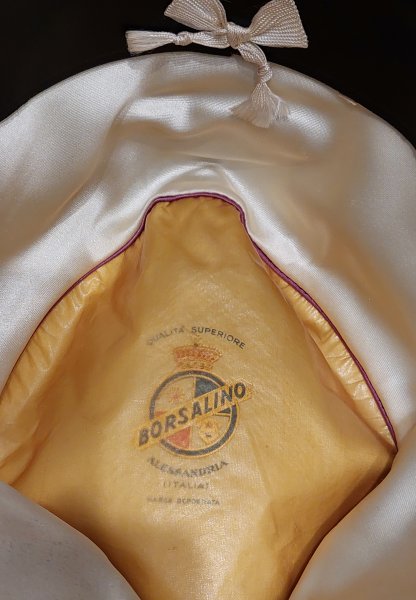
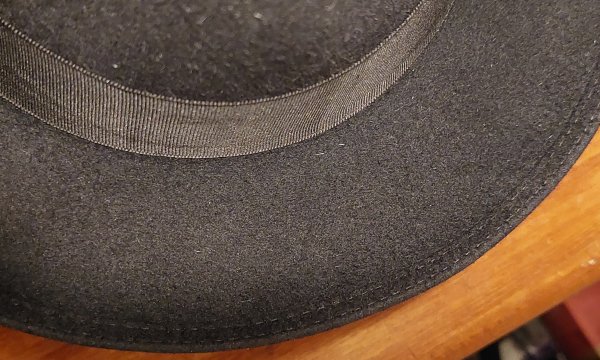
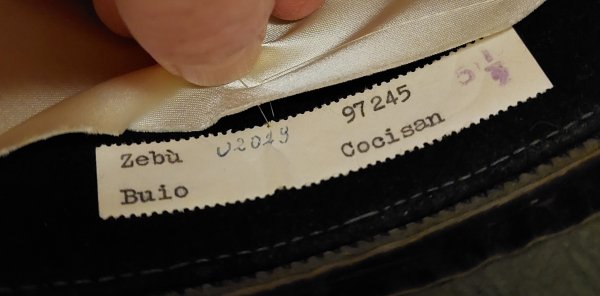
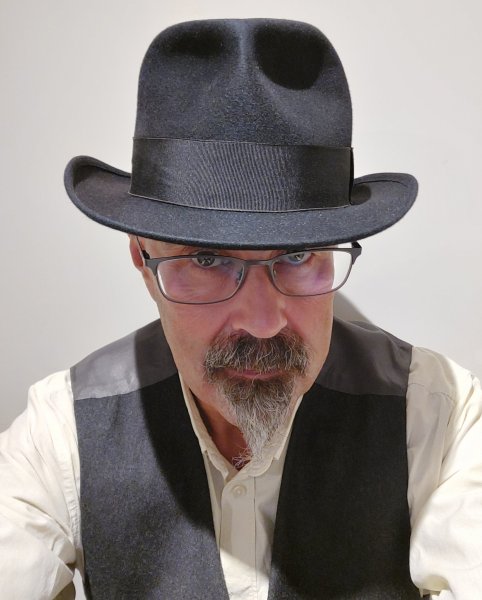
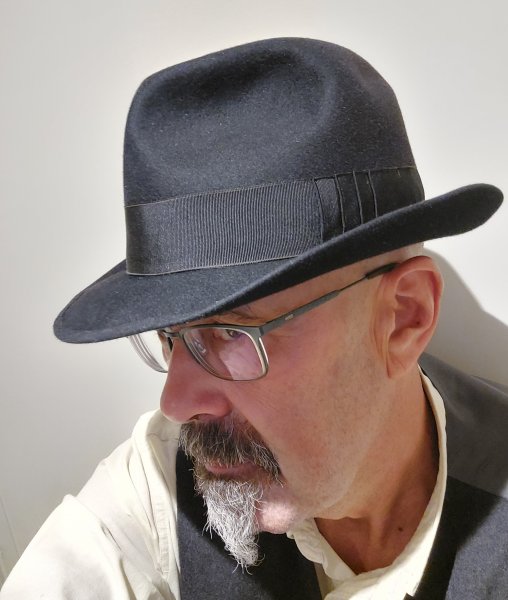
Late 1950s / early 60s if I'm reading the label right. Wonderful hand to the dense felt. Shark gill bow treatment, and a double stitched overwelt edge. The 5cm brim seems to say up, but can equally be worn down. Win-win.







PanosChris
Practically Family
- Messages
- 980
That's very nice! Maybe the indoor pics are misleading but I would expect to write misto on the label or the nap is somewhat longer?The second of the 6 recent Borsalino purchashes arrived today. Yet another Facebook Market Place find.
Late 1950s / early 60s if I'm reading the label right. Wonderful hand to the dense felt. Shark gill bow treatment, and a double stitched overwelt edge. The 5cm brim seems to say up, but can equally be worn down. Win-win.
View attachment 373450 View attachment 373451 View attachment 373452 View attachment 373453 View attachment 373454 View attachment 373455 View attachment 373457
Are 2 out of the 4 rest coming from the north?
Last edited:
That's very nice! Maybe the indoor pics are misleading but I would expect to write misto on the label or the nap is somewhat longer?
Are 2 out of the 4 rest coming from the north?
Thanks, Panos. The nap is indeed somewhat longer, but not what I'd call misto.
2 of the other 4 are indeed coming from the North. The other two, more South ;-)
That's a really good one, Steve. Love the gills. Unusual that the label has a different layout. If the "zebú" in the upper left is the colour of the felt, it is a colour we haven't seen before. We've only ever seen Buio as a felt colour once, so that is likely the case. Wouldn't know what else the "zebú" could refer to.The second of the 6 recent Borsalino purchashes arrived today. Yet another Facebook Market Place find.
Late 1950s / early 60s if I'm reading the label right. Wonderful hand to the dense felt. Shark gill bow treatment, and a double stitched overwelt edge. The 5cm brim seems to say up, but can equally be worn down. Win-win.
View attachment 373450 View attachment 373451 View attachment 373452 View attachment 373453 View attachment 373454 View attachment 373455 View attachment 373457
That's a really good one, Steve. Love the gills. Unusual that the label has a different layout. If the "zebú" in the upper left is the colour of the felt, it is a colour we haven't seen before. We've only ever seen Buio as a felt colour once, so that is likely the case. Wouldn't know what else the "zebú" could refer to.
Thanks Stefan. Ja, the label had me a bit confused, too.
- Messages
- 17,712
- Location
- Maryland
Steve, Super Form and Finish! Really like the Bow. Looks great on too!The second of the 6 recent Borsalino purchashes arrived today. Yet another Facebook Market Place find.
Late 1950s / early 60s if I'm reading the label right. Wonderful hand to the dense felt. Shark gill bow treatment, and a double stitched overwelt edge. The 5cm brim seems to say up, but can equally be worn down. Win-win.
View attachment 373450 View attachment 373451 View attachment 373452 View attachment 373453 View attachment 373454 View attachment 373455 View attachment 373457
Steve, Super Form and Finish! Really like the Bow. Looks great on too!
Thanks Steve
That's a really good one, Steve. Love the gills. Unusual that the label has a different layout. If the "zebú" in the upper left is the colour of the felt, it is a colour we haven't seen before. We've only ever seen Buio as a felt colour once, so that is likely the case. Wouldn't know what else the "zebú" could refer to.
Could it possibly refer to the shade of black seen on the Asien zebú cow? Borsalino were pretty inventive when it came to the names of colours.
It's certainly possible. Can't find any other meanings for the word "zebú", but the again: cryptic wording is one of Borsalino's hallmarks.Could it possibly refer to the shade of black seen on the Asien zebú cow? Borsalino were pretty inventive when it came to the names of colours.
It's certainly possible. Can't find any other meanings for the word "zebú", but the again: cryptic wording is one of Borsalino's hallmarks.
Indeed Stefan. The model designation Cocisan on mine bears little resemblance to, for example, your Cocisans.
Daniele Tanto
I'll Lock Up
- Messages
- 4,352
- Location
- Verona - Italia
"Buio - Dark" is the color. "Zebù" Bos taurus indicus an animal in Italian language, so is the finish of the surface felt. Cocisan is the type of hat
Featured products
-
 John Lofgren Monkey Boots Shinki Horsebuttt - $1,136 The classic monkey boot silhouette in an incredibly rich Shinki russet horse leather.
John Lofgren Monkey Boots Shinki Horsebuttt - $1,136 The classic monkey boot silhouette in an incredibly rich Shinki russet horse leather. -
 Grant Stone Diesel Boot Dark Olive Chromexcel - $395 Goodyear welted, Horween Chromexcel, classic good looks.
Grant Stone Diesel Boot Dark Olive Chromexcel - $395 Goodyear welted, Horween Chromexcel, classic good looks. -
 Schott 568 Vandals Jacket - $1,250 The classic Perfecto motorcycle jacket, in a very special limited-edition Schott double rider style.
Schott 568 Vandals Jacket - $1,250 The classic Perfecto motorcycle jacket, in a very special limited-edition Schott double rider style.
"Buio - Dark" is the color. "Zebù" Bos taurus indicus an animal in Italian language, so is the finish of the surface felt. Cocisan is the type of hat
Thank you for the clarification, Daniele. However, Cocisan seems to cover at least two types of hats. The Cocisan type is not as clear a definition as Bowler, Homburg, Fedora for example. Or am I missing something?
Daniele Tanto
I'll Lock Up
- Messages
- 4,352
- Location
- Verona - Italia
Steve, the Borsalino paper labels were and are, today even more than yesterday, a processing slip inside the factory, therefore they contain processing indications, some understandable such as the colors or the finish of the felt (see Zebù) but the name that here all refer to the type of hat is an abbreviation that determines the processes used for that batch of hats. There are no categories to which the shapes or proportions of a hat belong, they can be repeated, but there is very little evidence that these indications (Cocisan, Celesti, Mula, Ecosan and so on) refer to a single type of hat. They have often been used to determine, I repeat within the Borsalino departments, to indicate lots of hats for export. These indications are also linked to the manufacturing periods of hats in Borsalino, according to a series of procedures that have changed over the years and the curves of the markets. There are very vague connections between this terminology printed on the labels and the type of hats, while the colors and finishes of the felt are certainThank you for the clarification, Daniele. However, Cocisan seems to cover at least two types of hats. The Cocisan type is not as clear a definition as Bowler, Homburg, Fedora for example. Or am I missing something?
Steve, the Borsalino paper labels were and are, today even more than yesterday, a processing slip inside the factory, therefore they contain processing indications, some understandable such as the colors or the finish of the felt (see Zebù) but the name that here all refer to the type of hat is an abbreviation that determines the processes used for that batch of hats. There are no categories to which the shapes or proportions of a hat belong, they can be repeated, but there is very little evidence that these indications (Cocisan, Celesti, Mula, Ecosan and so on) refer to a single type of hat. They have often been used to determine, I repeat within the Borsalino departments, to indicate lots of hats for export. These indications are also linked to the manufacturing periods of hats in Borsalino, according to a series of procedures that have changed over the years and the curves of the markets. There are very vague connections between this terminology printed on the labels and the type of hats, while the colors and finishes of the felt are certain
Thank you Daniele for the clarification. It makes sense now; from a Borsalino perspective at least.
Daniele Tanto
I'll Lock Up
- Messages
- 4,352
- Location
- Verona - Italia
We introduce a Borsalino that has an unknown peculiarity in many hats of the house in Alessandria: its size is full, which is strange in the sizes of the Borsalino

Borsalino Qualità Suprema size 6 1/2 or 60 and 7 1/2 in the US.
 The color of the felt is "Lupo - Wolf" one of the most difficult to make true in photography
The color of the felt is "Lupo - Wolf" one of the most difficult to make true in photography

Medium felt finished with a tone-on-tone belt and a beautiful effect for global colors

Unlined and light weight is a hat from the seventies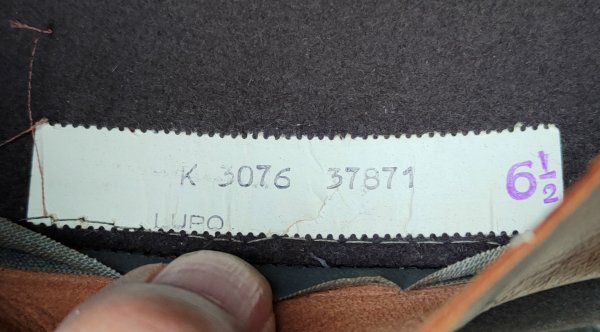
sold in Italy with a soft felt, rare to find in the Qualità Suprema.

These are measures of the Borsalino : the brims edged by a very thin ribbon to match the felt measure 6 cm. the ribbon in perfect color with the felt is 3 cm and the crown at its lowest point is at 10.

This too is too wide for my head and as well as the other hats size 60 or 7 1/2 showed these days it is in sale for now without remorse
Borsalino Qualità Suprema size 6 1/2 or 60 and 7 1/2 in the US.
Medium felt finished with a tone-on-tone belt and a beautiful effect for global colors
Unlined and light weight is a hat from the seventies

sold in Italy with a soft felt, rare to find in the Qualità Suprema.
These are measures of the Borsalino : the brims edged by a very thin ribbon to match the felt measure 6 cm. the ribbon in perfect color with the felt is 3 cm and the crown at its lowest point is at 10.
This too is too wide for my head and as well as the other hats size 60 or 7 1/2 showed these days it is in sale for now without remorse
Similar threads
- Replies
- 0
- Views
- 1K
Members online
- RickP
- zacharge
- Pavedrvr
- Cane sciolto
- Manu Mohan
- BaslerChrysler
- Mplouis54
- Dortreo
- voodootomato
- Ron86
- Carrie @ Thurston Bros.
- Pandakill
- TheWickerMan
- drewlesch
- Bucket
- Leathergato
- greatpa
- ObiJuanValdez
- RideTilSunset
- Doctor Strange
- jfan
- gmaki
- regius
- jay_cali
- thammer
- DavidT
- G007
- Nousdefions18e
- npthaiduong
- Cskarev
- Herrvallmo
- AeroFan_07
- Trim Man
- IrishStu
- freeyourmind
- Ai-Phu-Gyu
- r.biker
- lepilo
- Stu K 323
- Khilij
- Fading Fast
- Craig from Craigslist
- Trouser Bark
- Mercure
- twentyfiveshells
- rentoid
- Bewear88
- canvas
- Thearikmor
- tonyb
Total: 3,128 (members: 77, guests: 3,051)